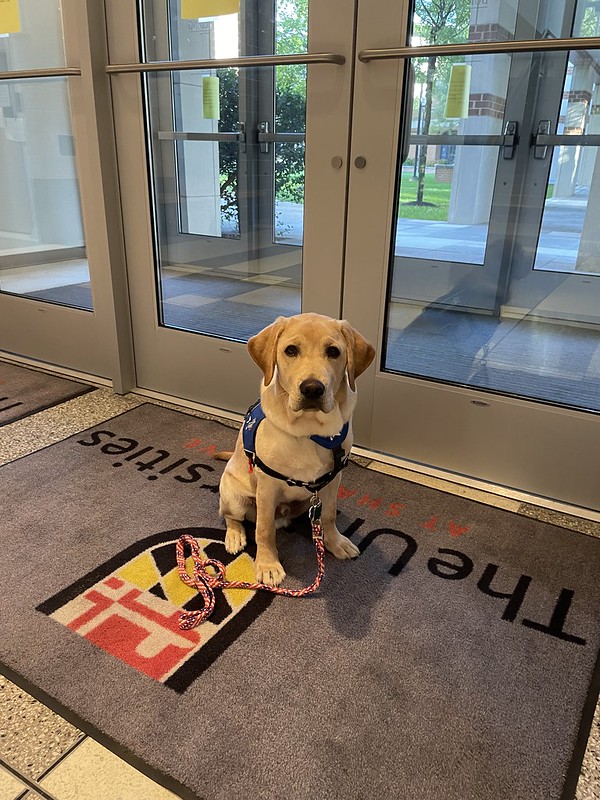Doggone It!
May 16, 2024 Giordana Segneri
Heath, a yellow Labrador, has inextricably bound two UMSON employees at the Universities at Shady Grove.
Warrior Canine Connection’s (WCC) Heath, a yellow Labrador, was named after a World War II sailor, U.S. Navy Chief Petty Officer Charles Thomas Heath. WCC’s Heath, a service dog in training (SDIT), was born April 10, 2023, as one of a litter of six and bounded into Brigitte Bard’s life when he was 9 weeks old; she had volunteered to serve as a Puppy Parent, raising and training Heath for 18 to 24 months, preparing him for an eventual life with a veteran. WCC is a nonprofit organization that trains service dogs for wounded veterans.
Puppy Parents have a big job: They go through training before being matched with a puppy, who then goes everywhere with the Puppy Parent — into stores, providers’ offices, airplanes, etc. Puppy Parents commit to taking their SDITs to weekly training at WCC and then reinforcing the training daily.
Bard, assistant director of student services, made bringing Heath to UMSON’s building at the Universities at Shady Grove (USG) part of his training, so he could be socialized through interactions with students and employees. The USG environment also provided opportunities for Heath to acclimate to all sorts of things: elevators, parking garages, stairs, automatic doors, noises, textures, and learning to be in a crate without barking or crying when left alone in Bard’s office.
“Raising and training Heath has been the most rewarding volunteer work I have ever done,” says Bard, who is the mother of two military service members, one Army and one Marines. “It changed my life. I learned so much about dogs, how to read them, and so much about training them. I also met a whole new community of people who are doing amazing and selfless work for our veterans and military families.”
Heath, however, was deemed not to have the specific characteristics necessary to serve a vet. “Heath loved people a little too much and he would not focus on me, his handler, when he saw another dog,” Bard explains. “He was also body sensitive to the harness and vest. Then there were the home appliances, like vacuums, coffee grinders, blenders, etc., that he barked at.” This isn’t unusual, Bard notes, indicating that nationwide, only about 20 percent of service dogs in this kind of training enter service to a vet. Instead, they can serve in other capacities as ambassador dogs, breeding dogs, or resident therapy dogs at institutions that provide services for vets.
WCC determined that Heath would be a better fit for an active military family. Enter Jen Dalton, PhD, RN, CNE, CHSE, assistant professor, who had gotten to know Heath at USG and whose husband is in the U.S. Navy, making them eligible to adopt him. And they did, officially, last December. “I knew when I decided to be a Puppy Parent that the hardest part was going to be letting Heath go, but at the same time, I kept thinking about the comfort and support Heath was going to bring to a veteran or a military family,” Bard says. “It's lovely how the universe puts all the stars in order sometimes and things come full circle. Heath and I were on a mission, and it led him straight to Jen and her family. It makes this experience extra special.”
Dalton says Heath has kept her 8-year-old daughter, Caroline, who had been asking for a puppy for a while, “very busy and increased her level of confidence and independence.”
“Heath keeps us on our toes and really adds laughter and snuggles to our daily routine,” Dalton says. “I’m forever grateful to Brigitte for bringing him into our lives at USG.”
photos courtesy of Brigitte Bard and Jennifer Dalton
We promise this will make your day better: Watch the WCC Puppy Cam
About U.S. Navy Chief Petty Officer Charles Heath
This information was provided by Warrior Canine Connection.
Charles Heath was raised in Fireco, W. Va. Upon his graduation from high school in 1940, Heath enlisted in the U.S. Navy and served in World War II. He completed boot camp at Norfolk Naval Training Center in Norfolk, Va., before being stationed on the USS Wyoming. He served on the USS Wyoming for two years before moving to the Naval Receiving Station briefly and transferring to the newly established Amphibious Training Base at Little Creek, Va.
In 1943, Heath was stationed on the cruiser USS Savannah. While he was stationed there, the cruiser was bombed, severely damaging the ship and killing 206 of Heath’s fellow sailors. Heath was then stationed on the USS Vicksburg in 1944 before being transferred to the Norfolk Naval Supply Center for two years.
Throughout his 20 years of service, Heath also served in Hawaii, Japan, and Washington, D.C. He retired from the U.S. Navy in 1960 and went on to work for an additional 20 years as a civil servant in personnel and security in Maryland. After retiring, he continued to volunteer, especially in support of his fellow service members and his church. He passed away in 2019 and is remembered as a loving father, grandfather, and well-loved and respected community member.